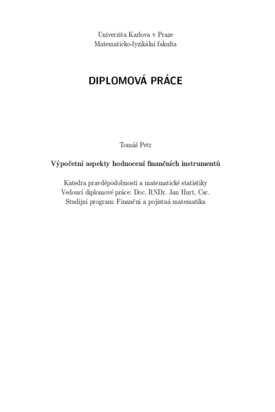Výpočetní aspekty hodnocení finančních instrumentů
Computational Aspects of Financial Instruments
diploma thesis (DEFENDED)

View/
Permanent link
http://hdl.handle.net/20.500.11956/4459Identifiers
Study Information System: 42473
CU Caralogue: 990008680130106986
Collections
- Kvalifikační práce [11973]
Author
Advisor
Referee
Myška, Petr
Faculty / Institute
Faculty of Mathematics and Physics
Discipline
Financial and insurance mathematics
Department
Department of Probability and Mathematical Statistics
Date of defense
26. 5. 2006
Publisher
Univerzita Karlova, Matematicko-fyzikální fakultaLanguage
Czech
Grade
Excellent
Tato práce pojednává o možnostech ohodnocení finančních derivátů. Jsou zde vysvětleny zejména matematické postupy používané k modelování vývoje náhodných veličin představujících vývoj cen podkladových aktiv těchto derivátů a úrokových měr. Na základě tohoto vývoje je pak odvozeno ocenění různých finančních derivátů, zejména opcí, za použití rizikově neutrální pravděpodobností míry. Jsou zde uvedeny nejen analytické postupy ocenění, zejména postupy navazující na Blackův-Scholesův vzorec pro ocenění evropských call a put opcí, ale také různé simulační a numerické metody pro oceňování a modelování průběhu cen a úrokových měr na základě jejich předpokládaného rozdělení. Krátce jsou zmíněny i modely ARCH a GARCH pro odhadování parametrů vývoje úrokových měr a indexů. V závěru jsou pak uvedené postupy srovnány použitím na příkladu skutečných dat. Jsou porovnány zejména různé postupy pro ocenění nejběžnějších typů opcí - analytický postup (je-li k dispozici), simulace ceny podkladového aktiva konstrukcí binomického stromového modelu, simulace jednotlivých trajektorií metodou Monte Carlo.
This work deals with the possibilities of financial derivatives pricing. Explained are especially mathematical approaches used for modelling the development of random variables, which represent the evolution of underlying securities and interest rates. Based on this representation is then derived the pricing of various financial derivatives, mainly options, using the risk-neutral probability measure. Both the analytical pricing methods, especially those extending the Black-Scholes formula for European call and put options pricing, and the numerical and simulation pricing methods for modelling prices and interest rates based on assumptions about their distribution are involved. Mentioned are also ARCH and GARCH models for estimation of interest rates and indices distribution parametres. At the end of the work are these methods compared by application on an example of market data. Compared are various models to price the most usual types of options - analytical pricing (if available), underlying security price simulation by construction of binomial tree model, simulation of particular trajectories by Monte Carlo method.
